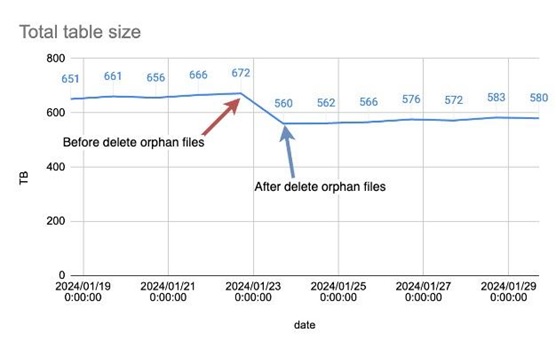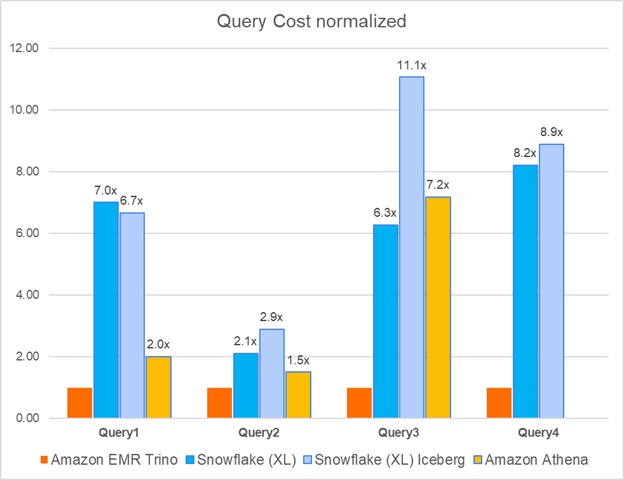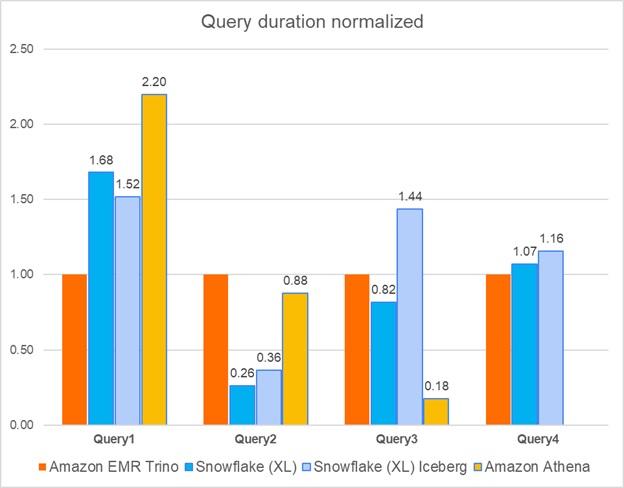This post is co-written with Amit Gilad, Alex Dickman and Itay Takersman from Cloudinary.
Enterprises and organizations across the globe want to harness the power of data to make better decisions by putting data at the center of every decision-making process. Data-driven decisions lead to more effective responses to unexpected events, increase innovation and allow organizations to create better experiences for their customers. However, throughout history, data services have held dominion over their customers’ data. Despite the potential separation of storage and compute in terms of architecture, they are often effectively fused together. This amalgamation empowers vendors with authority over a diverse range of workloads by virtue of owning the data. This authority extends across realms such as business intelligence, data engineering, and machine learning thus limiting the tools and capabilities that can be used.
The landscape of data technology is swiftly advancing, driven frequently by projects led by the open source community in general and the Apache foundation specifically. This evolving open source landscape allows customers complete control over data storage, processing engines and permissions expanding the array of available options significantly. This approach also encourages vendors to compete based on the value they provide to businesses, rather than relying on potential fusing of storage and compute. This fosters a competitive environment that prioritizes customer acquisition and prompts vendors to differentiate themselves through unique features and offerings that cater directly to the specific needs and preferences of their clientele.
A modern data strategy redefines and enables sharing data across the enterprise and allows for both reading and writing of a singular instance of the data using an open table format. The open table format accelerates companies’ adoption of a modern data strategy because it allows them to use various tools on top of a single copy of the data.
Cloudinary is a cloud-based media management platform that provides a comprehensive set of tools and services for managing, optimizing, and delivering images, videos, and other media assets on websites and mobile applications. It’s widely used by developers, content creators, and businesses to streamline their media workflows, enhance user experiences, and optimize content delivery.
In this blog post, we dive into different data aspects and how Cloudinary breaks the two concerns of vendor locking and cost efficient data analytics by using Apache Iceberg, Amazon Simple Storage Service (Amazon S3), Amazon Athena, Amazon EMR, and AWS Glue.
Short overview of Cloudinary’s infrastructure
Cloudinary infrastructure handles over 20 billion requests daily with every request generating event logs. Various data pipelines process these logs, storing petabytes (PBs) of data per month, which after processing data stored on Amazon S3, are then stored in Snowflake Data Cloud. These datasets serve as a critical resource for Cloudinary internal teams and data science groups to allow detailed analytics and advanced use cases.
Until recently, this data was mostly prepared by automated processes and aggregated into results tables, used by only a few internal teams. Cloudinary struggled to use this data for additional teams who had more online, real time, lower-granularity, dynamic usage requirements. Making petabytes of data accessible for ad-hoc reports became a challenge as query time increased and costs skyrocketed along with growing compute resource requirements. Cloudinary data retention for the specific analytical data discussed in this post was defined as 30 days. However, new use cases drove the need for increased retention, which would have led to significantly higher cost.
The data is flowing from Cloudinary log providers into files written into Amazon S3 and notified through events pushed to Amazon Simple Queue Service (Amazon SQS). Those SQS events are ingested by a Spark application running in Amazon EMR Spark, which parses and enriches the data. The processed logs are written in Apache Parquet format back to Amazon S3 and then automatically loaded to a Snowflake table using Snowpipe.

Why Cloudinary chose Apache Iceberg
Apache Iceberg is a high-performance table format for huge analytic workloads. Apache Iceberg brings the reliability and simplicity of SQL tables to big data, while making it possible for processing engines such as Apache Spark, Trino, Apache Flink, Presto, Apache Hive, and Impala to safely work with the same tables at the same time.
A solution based on Apache Iceberg encompasses complete data management, featuring simple built-in table optimization capabilities within an existing storage solution. These capabilities, along with the ability to use multiple engines on top of a singular instance of data, helps avoid the need for data movement between various solutions.
While exploring the various controls and options in configuring Apache Iceberg, Cloudinary had to adapt its data to use AWS Glue Data Catalog, as well as move a significant volume of data to Apache Iceberg on Amazon S3. At this point it became clear that costs would be significantly reduced, and while it had been a key factor since the planning phase, it was now possible to get concrete numbers. One example is that Cloudinary was now able to store 6 months of data for the same storage price that was previously paid for storing 1 month of data. This cost saving was achieved by using Amazon S3 storage tiers as well as improved compression (Zstandard), further enhanced by the fact that Parquet files were sorted.
Since Apache Iceberg is well supported by AWS data services and Cloudinary was already using Spark on Amazon EMR, they could integrate writing to Data Catalog and start an additional Spark cluster to handle data maintenance and compaction. As exploration continued with Apache Iceberg, some interesting performance metrics were found. For example, for certain queries, Athena runtime was 2x–4x faster than Snowflake.
Integration of Apache Iceberg
The integration of Apache Iceberg was done before loading data to Snowflake. The data is written to an Iceberg table using Apache Parquet data format and AWS Glue as the data catalog. In addition, a Spark application on Amazon EMR runs in the background handling compaction of the Parquet files to optimal size for querying through various tools such as Athena, Trino running on top of EMR, and Snowflake.

Challenges faced
Cloudinary faced several challenges while building its petabyte-scale data lake, including:
- Determining optimal table partitioning
- Optimizing ingestion
- Solving the small files problem to improve query performance
- Cost effectively maintaining Apache Iceberg tables
- Choosing the right query engine
In this section, we describe each of these challenges and the solutions implemented to address them. Many of the tests to check performance and volumes of data scanned have used Athena because it provides a simple to use, fully serverless, cost effective, interface without the need to setup infrastructure.
Determining optimal table partitioning
Apache Iceberg makes partitioning easier for the user by implementing hidden partitioning. Rather than forcing the user to supply a separate partition filter at query time, Iceberg tables can be configured to map regular columns to the partition keys. Users don’t need to maintain partition columns or even understand the physical table layout to get fast and accurate query results.
Iceberg has several partitioning options. One example is when partitioning timestamps, which can be done by year, month, day, and hour. Iceberg keeps track of the relationship between a column value and its partition without requiring additional columns. Iceberg can also partition categorical column values by identity, hash buckets, or truncation. In addition, Iceberg partitioning is user-friendly because it also allows partition layouts to evolve over time without breaking pre-written queries. For example, when using daily partitions and the query pattern changes over time to be based on hours, it’s possible to evolve the partitions to hourly ones, thus making queries more efficient. When evolving such a partition definition, the data in the table prior to the change is unaffected, as is its metadata. Only data that is written to the table after the evolution is partitioned with the new definition, and the metadata for this new set of data is kept separately. When querying, each partition layout’s respective metadata is used to identify the files that need to be accessed; this is called split-planning. Split-planning is one of many Iceberg features that are made possible due to the table metadata, which creates a separation between the physical and the logical storage. This concept makes Iceberg extremely versatile.
Determining the correct partitioning is key when working with large data sets because it affects query performance and the amount of data being scanned. Because this migration was from existing tables from Snowflake native storage to Iceberg, it was crucial to test and provide a solution with the same or better performance for the existing workload and types of queries.
These tests were possible due to Apache Iceberg’s:
- Hidden partitions
- Partition transformations
- Partition evolution
These allowed altering table partitions and testing which strategy works best without data rewrite.
Here are a few partitioning strategies that were tested:
PARTITIONED BY (days(day), customer_id)PARTITIONED BY (days(day), hour(timestamp))PARTITIONED BY (days(day), bucket(N, customer_id))PARTITIONED BY (days(day))
Each partitioning strategy that was reviewed generated significantly different results both during writing as well as during query time. After careful results analysis, Cloudinary decided to partition the data by day and combine it with sorting, which allows them to sort data within partitions as would be elaborated in the compaction section.
Optimizing ingestion
Cloudinary receives billions of events in files from its providers in various formats and sizes and stores those on Amazon S3, resulting in terabytes of data processed and stored every day.
Because the data doesn’t come in a consistent manner and it’s not possible to predict the incoming rate and file size of the data, it was necessary to find a way of keeping cost down while maintaining high throughput.
This was achieved by using EventBridge to push each file received into Amazon SQS, where it was processed using Spark running on Amazon EMR in batches. This allowed processing the incoming data at high throughput and scale clusters according to queue size while keeping costs down.
Example of fetching 100 messages (files) from Amazon SQS with Spark:
var client = AmazonSQSClientBuilder.standard().withRegion("us-east-1").build()
var getMessageBatch: Iterable[Message] = DistributedSQSReceiver.client.receiveMessage(new ReceiveMessageRequest().withQueueUrl(queueUrl).withMaxNumberOfMessages(10)).getMessages.asScala
sparkSession.sparkContext.parallelize(10) .map(_ => getMessageBatch) .collect().flatMap(_.toList) .toList
When dealing with a high data ingestion rate for a specific partition prefix, Amazon S3 might potentially throttle requests and return a 503 status code (service unavailable). To address this scenario, Cloudinary used an Iceberg table property called write.object-storage.enabled, which incorporates a hash prefix into the stored Amazon S3 object path. This approach was deemed efficient and effectively mitigated Amazon S3 throttling problems.
Solving the small file problem and improving query performance
In modern data architectures, stream processing engines such as Amazon EMR are often used to ingest continuous streams of data into data lakes using Apache Iceberg. Streaming ingestion to Iceberg tables can suffer from two problems:
- It generates many small files that lead to longer query planning, which in turn can impact read performance.
- Poor data clustering, which can make file pruning less effective. This typically occurs in the streaming process when there is insufficient new data to generate optimal file sizes for reading, such as 512 MB.
Because partition is a key factor in the number of files produced and Cloudinary’s data is time based and most queries use a time filter, it was decided to address the optimization of our data lake in multiple ways.
First, Cloudinary set all the necessary configurations that helped reduce the number of files while appending data in the table by setting write.target-file-size-bytes, which allows defining the default target file size. Setting spark.sql.shuffle.partitions in Spark can reduce the number of output files by controlling the number of partitions used during shuffle operations, which affects how data is distributed across tasks, consequently minimizing the number of output files generated after transformations or aggregations.
Because the above approach only addressed the small file problem but didn’t eliminate it entirely, Cloudinary used another capability of Apache Iceberg that can compact data files in parallel using Spark with the rewriteDataFiles action. This action combines small files into larger files to reduce metadata overhead and minimize the amount of Amazon S3 GetObject API operation usage.
Here is where it can get complicated. When running compaction, Cloudinary needed to choose which strategy to apply out of the three that Apache Iceberg offers; each one having its own advantages and disadvantages:
- Binpack – simply rewrites smaller files to a target size
- Sort – data sorting based on different columns
- Z-order – a technique to colocate related data in the same set of files
At first, the Binpack compaction strategy was evaluated. This strategy works fastest and combines small files together to reach the target file size defined and after running it a significant improvement in query performance was observed.
As mentioned previously, data was partitioned by day and most queries ran on a specific time range. Because data comes from external vendors and sometimes arrives late, it was noticed that when running queries on compacted days, a lot of data was being scanned, because the specific time range could reside across many files. The query engine (Athena, Snowflake, and Trino with Amazon EMR) needed to scan the entire partition to fetch only the relevant rows.
To increase query performance even further, Cloudinary decided to change the compaction process to use sort, so now data is partitioned by day and sorted by requested_at (timestamp when the action occurred) and customer ID.
This strategy is costlier for compaction because it needs to shuffle the data in order to sort it. However, after adopting this sort strategy, two things were noticeable: the same queries that ran before now scanned around 50 percent less data, and query run time was improved by 30 percent to 50 percent.
Cost effectively maintaining Apache Iceberg tables
Maintaining Apache Iceberg tables is crucial for optimizing performance, reducing storage costs, and ensuring data integrity. Iceberg provides several maintenance operations to keep your tables in good shape. By incorporating these operations Cloudinary were able to cost-effectively manage their Iceberg tables.
Expire snapshots
Each write to an Iceberg table creates a new snapshot, or version, of a table. Snapshots can be used for time-travel queries, or the table can be rolled back to any valid snapshot.
Regularly expiring snapshots is recommended to delete data files that are no longer needed and to keep the size of table metadata small. Cloudinary decided to retain snapshots for up to 7 days to allow easier troubleshooting and handling of corrupted data which sometimes arrives from external sources and aren’t identified upon arrival. SparkActions.get().expireSnapshots(iceTable).expireOlderThan(TimeUnit.DAYS.toMillis(7)).execute()
Remove old metadata files
Iceberg keeps track of table metadata using JSON files. Each change to a table produces a new metadata file to provide atomicity.
Old metadata files are kept for history by default. Tables with frequent commits, like those written by streaming jobs, might need to regularly clean metadata files.
Configuring the following properties will make sure that only the latest ten metadata files are kept and anything older is deleted.
write.metadata.delete-after-commit.enabled=true
write.metadata.previous-versions-max=10
Delete orphan files
In Spark and other distributed processing engines, when tasks or jobs fail, they might leave behind files that aren’t accounted for in the table metadata. Moreover, in certain instances, the standard snapshot expiration process might fail to identify files that are no longer necessary and not delete them.
Apache Iceberg offers a deleteOrphanFiles action that will take care of unreferenced files. This action might take a long time to complete if there are a large number of files in the data and metadata directories. A metadata or data file is considered orphan if it isn’t reachable by any valid snapshot. The set of actual files is built by listing the underlying storage using the Amazon S3 ListObjects operation, which makes this operation expensive. It’s recommended to run this operation periodically to avoid increased storage usage; however, too frequent runs can potentially offset this cost benefit.
A good example of how critical it is to run this procedure is to look at the following diagram, which shows how this procedure removed 112 TB of storage.

Rewriting manifest files
Apache Iceberg uses metadata in its manifest list and manifest files to speed up query planning and to prune unnecessary data files. Manifests in the metadata tree are automatically compacted in the order that they’re added, which makes queries faster when the write pattern aligns with read filters.
If a table’s write pattern doesn’t align with the query read filter pattern, metadata can be rewritten to re-group data files into manifests using rewriteManifests.
While Cloudinary already had a compaction process that optimized data files, they noticed that manifest files also required optimization. It turned out that in certain cases, Cloudinary reached over 300 manifest files—which were small, often under 8Mb in size—and due to late arriving data, manifest files were pointing to data in different partitions. This caused query planning to run for 12 seconds for each query.
Cloudinary initiated a separate scheduled process of rewriteManifests, and after it ran, the number of manifest files was reduced to approximately 170 files and as a result of more alignment between manifests and query filters (based on partitions), query planning was improved by three times to approximately 4 seconds.
Choosing the right query engine
As part of Cloudinary exploration aimed at testing various query engines, they initially outlined several key performance indicators (KPIs) to guide their search, including support for Apache Iceberg alongside integration with existing data sources such as MySQL and Snowflake, the availability of a web interface for effortless one-time queries, and cost optimization. In line with these criteria, they opted to evaluate various solutions including Trino on Amazon EMR, Athena, and Snowflake with Apache Iceberg support (at that time it was available as a Private Preview). This approach allowed for the assessment of each solution against defined KPIs, facilitating a comprehensive understanding of their capabilities and suitability for Cloudinary’s requirements.
Two of the more quantifiable KPIs that Cloudinary was planning to evaluate were cost and performance. Cloudinary realized early in the process that different queries and usage types can potentially benefit from different runtime engines. They decided to focus on four runtime engines.
| Engine | Details |
| Snowflake native | XL data warehouse on top of data stored within Snowflake |
| Snowflake with Apache Iceberg support | XL data warehouse on top of data stored in S3 in Apache Iceberg tables |
| Athena | On-demand mode |
| Amazon EMR Trino | Opensource Trino on top of eight nodes (m6g.12xl) cluster |
The test included four types of queries that represent different production workloads that Cloudinary is running. They’re ordered by size and complexity from the simplest one to the most heavy and complex.
| Query | Description | Data scanned | Returned results set |
| Q1 | Multi-day aggregation on a single tenant | Single digit GBs | <10 rows |
| Q2 | Single-day aggregation by tenant across multiple tenant | Dozens of GBs | 100 thousand rows |
| Q3 | Multi-day aggregation across multiple tenants | Hundreds of GBs | <10 rows |
| Q4 | Heavy series of aggregations and transformations on a multi-tenant dataset to derive access metrics | Single digit TBs | >1 billion rows |
The following graphs show the cost and performance of the four engines across the different queries. To avoid chart scaling issues, all costs and query durations were normalized based on Trino running on Amazon EMR. Cloudinary considered Query 4 to be less suitable for Athena because it involved processing and transforming extremely large volumes of complex data.
Some important aspects to consider are:
- Cost for EMR running Trino was derived based on query duration only, without considering cluster set up, which on average launches in just under 5 minutes.
- Cost for Snowflake (both options) was derived based on query duration only, without considering cold start (more than 10 seconds on average) and a Snowflake warehouse minimum charge of 1 minute.
- Cost for Athena was based on the amount of data scanned; Athena doesn’t require cluster set up and the query queue time is less than 1 second.
- All costs are based on list on-demand (OD) prices.
- Snowflake prices are based on Standard edition.

The above chart shows that, from a cost perspective, Amazon EMR running Trino on top of Apache Iceberg tables was superior to other engines, in certain cases up to ten times less expensive. However, Amazon EMR setup requires additional expertise and skills compared to the no-code, no infrastructure management offered by Snowflake and Athena.

In terms of query duration, it’s noticeable that there’s no clear engine of choice for all types of queries. In fact, Amazon EMR, which was the most cost-effective option, was only fastest in two out of the four query types. Another interesting point is that Snowflake’s performance on top of Apache Iceberg is almost on-par with data stored within Snowflake, which adds another great option for querying their Apache Iceberg data-lake. The following table shows the cost and time for each query and product.
| . | Amazon EMR Trino | Snowflake (XL) | Snowflake (XL) Iceberg | Athena |
| Query1 | $0.01 5 seconds |
$0.08 8 seconds |
$0.07 8 seconds |
$0.02 11 seconds |
| Query2 | $0.12 107 seconds |
$0.25 28 seconds |
$0.35 39 seconds |
$0.18 94 seconds |
| Query3 | $0.17 147 seconds |
$1.07 120 seconds |
$1.88 211 seconds |
$1.22 26 seconds |
| Query4 | $6.43 1,237 seconds |
$11.73 1,324 seconds |
$12.71 1,430 seconds |
N/A |
Benchmarking conclusions
While every solution presents its own set of advantages and drawbacks—whether in terms of pricing, scalability, optimizing for Apache Iceberg, or the contrast between open source versus closed source—the beauty lies in not being constrained to a single choice. Embracing Apache Iceberg frees you from relying solely on a single solution. In certain scenarios where queries must be run frequently while scanning up to hundreds of gigabytes of data with an aim to evade warm-up periods and keep costs down, Athena emerged as the best choice. Conversely, when tackling hefty aggregations that demanded significant memory allocation while being mindful of cost, the preference leaned towards using Trino on Amazon EMR. Amazon EMR was significantly more cost efficient when running longer queries, because boot time cost could be discarded. Snowflake stood out as a great option when queries could be joined with other tables already residing within Snowflake. This flexibility allowed harnessing the strengths of each service, strategically applying them to suit the specific needs of various tasks without being confined to a singular solution.
In essence, the true power lies in the ability to tailor solutions to diverse requirements, using the strengths of different environments to optimize performance, cost, and efficiency.
Conclusion
Data lakes built on Amazon S3 and analytics services such as Amazon EMR and Amazon Athena, along with the open source Apache Iceberg framework, provide a scalable, cost-effective foundation for modern data architectures. It enables organizations to quickly construct robust, high-performance data lakes that support ACID transactions and analytics workloads. This combination is the most refined way to have an enterprise-grade open data environment. The availability of managed services and open source software helps companies to implement data lakes that meet their needs.
Since building a data lake solution on top of Apache Iceberg, Cloudinary has seen major enhancements. The data lake infrastructure enables Cloudinary to extend their data retention by six times while lowering the cost of storage by over 25 percent. Furthermore, query costs dropped by more than 25–40 percent thanks to the efficient querying capabilities of Apache Iceberg and the query optimizations provided in the Athena version 3, which is now based on Trino as its engine. The ability to retain data for longer as well as providing it to various stakeholders while reducing cost is a key component in allowing Cloudinary to be more data driven in their operation and decision-making processes.
Using a transactional data lake architecture that uses Amazon S3, Apache Iceberg, and AWS Analytics services can greatly enhance an organization’s data infrastructure. This allows for sophisticated analytics and machine learning, fueling innovation while keeping costs down and allowing the use of a plethora of tools and services without limits.
About the Authors
 Yonatan Dolan is a Principal Analytics Specialist at Amazon Web Services. He is located in Israel and helps customers harness AWS analytical services to leverage data, gain insights, and derive value. Yonatan is an Apache Iceberg evangelist.
Yonatan Dolan is a Principal Analytics Specialist at Amazon Web Services. He is located in Israel and helps customers harness AWS analytical services to leverage data, gain insights, and derive value. Yonatan is an Apache Iceberg evangelist.
 Amit Gilad is a Senior Data Engineer on the Data Infrastructure team at Cloudinar. He is currently leading the strategic transition from traditional data warehouses to a modern data lakehouse architecture, utilizing Apache Iceberg to enhance scalability and flexibility.
Amit Gilad is a Senior Data Engineer on the Data Infrastructure team at Cloudinar. He is currently leading the strategic transition from traditional data warehouses to a modern data lakehouse architecture, utilizing Apache Iceberg to enhance scalability and flexibility.
 Alex Dickman is a Staff Data Engineer on the Data Infrastructure team at Cloudinary. He focuses on engaging with various internal teams to consolidate the team’s data infrastructure and create new opportunities for data applications, ensuring robust and scalable data solutions for Cloudinary’s diverse requirements.
Alex Dickman is a Staff Data Engineer on the Data Infrastructure team at Cloudinary. He focuses on engaging with various internal teams to consolidate the team’s data infrastructure and create new opportunities for data applications, ensuring robust and scalable data solutions for Cloudinary’s diverse requirements.
 Itay Takersman is a Senior Data Engineer at Cloudinary data infrastructure team. Focused on building resilient data flows and aggregation pipelines to support Cloudinary’s data requirements.
Itay Takersman is a Senior Data Engineer at Cloudinary data infrastructure team. Focused on building resilient data flows and aggregation pipelines to support Cloudinary’s data requirements.
- SEO Powered Content & PR Distribution. Get Amplified Today.
- PlatoData.Network Vertical Generative Ai. Empower Yourself. Access Here.
- PlatoAiStream. Web3 Intelligence. Knowledge Amplified. Access Here.
- PlatoESG. Carbon, CleanTech, Energy, Environment, Solar, Waste Management. Access Here.
- PlatoHealth. Biotech and Clinical Trials Intelligence. Access Here.
- Source: https://aws.amazon.com/blogs/big-data/how-cloudinary-transformed-their-petabyte-scale-streaming-data-lake-with-apache-iceberg-and-aws-analytics/



